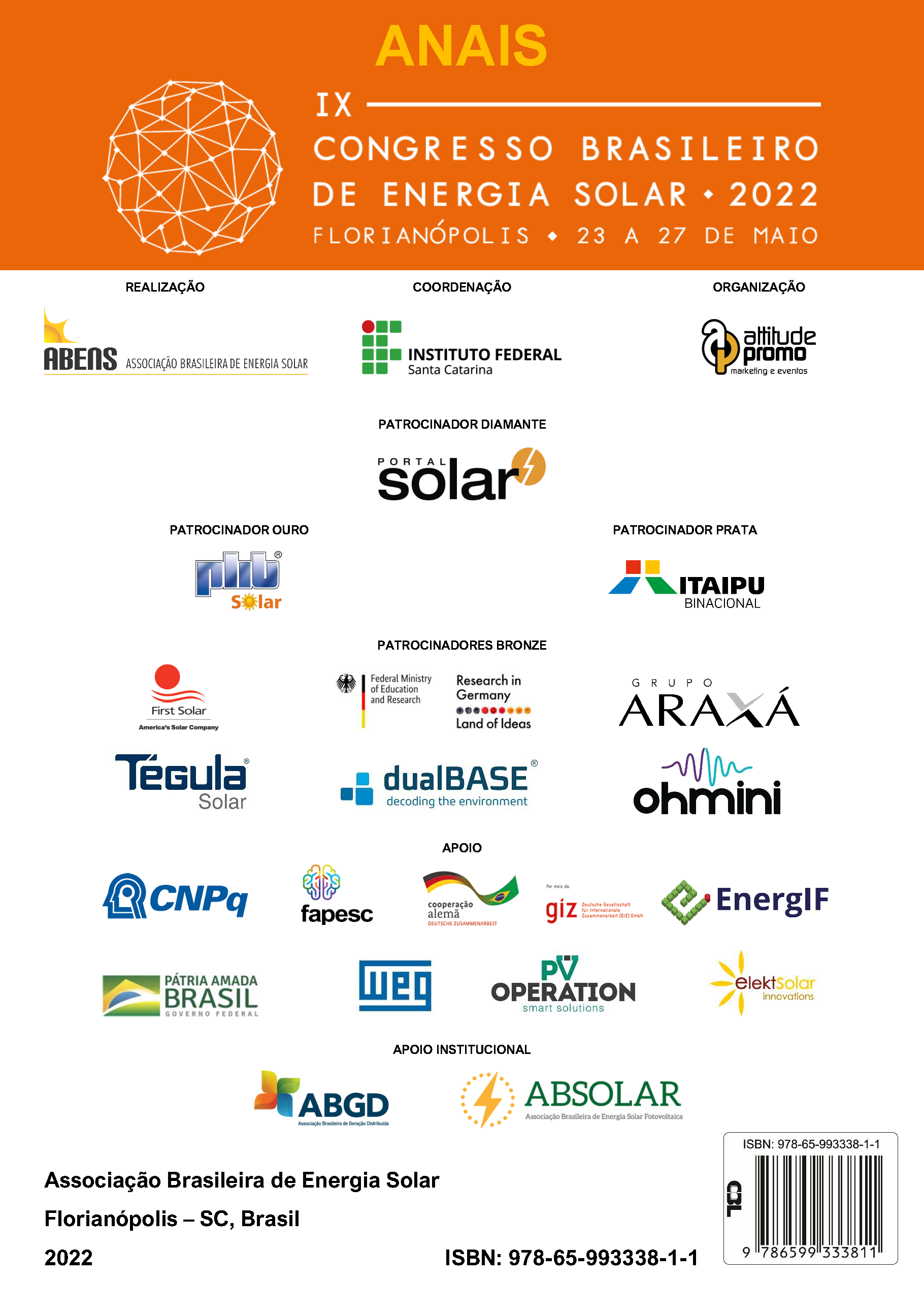DIFERENTES MÉTODOS DE EXTRAÇÃO DE NÍVEIS DE SUJIDADE APLICADOS EM DISTINTOS CLIMAS
DOI:
https://doi.org/10.59627/cbens.2022.1153Palavras-chave:
Energia Solar, Fotovoltaica, SujidadeResumo
A deposição de poeira na superfície dos módulos fotovoltaicos (FV) causa perdas significativas nos sistemas fotovoltaicos, com quedas de energia de até 50% em algumas regiões. Isso significa que pode levar a grandes perdas financeiras devido ao menor rendimento de energia dos sistemas fotovoltaicos e aos custos de Operação & Manutenção (O&M) mais altos e à incerteza no desempenho fotovoltaico. Portanto, monitorar e quantificar com precisão a sujeira é essencial para estabelecer um cronograma de limpeza ideal. O escopo deste trabalho é apresentar a metodologia de extração de perdas de sujidade em tempo real para sistemas fotovoltaicos (PV) localizados em distintas condições climáticas. Este trabalho descreve várias metodologias para quantificar as perdas de sujeira usando dados de desempenho fotovoltaico, sem a necessidade de estações de sujeira ou custos adicionais de mão de obra e manutenção. A aplicabilidade das distintas metodologias é validada nas distintas localidades, apresentando valores médios extraídos de índices de sujidade de 0.98 para Jaén e Nicósia e 0.99 para Sidirokastro. Esses dados explicitam as características climáticas de cada localidade, fator que afeta diretamente a análise da sujidade em sistemas fotovoltaicos.
Downloads
Referências
AlDowsari, A., Bkayrat, R., AlZain, H., Shahin, T., 2014. Best practices for mitigating soiling risk on PV power plants. 2014 Saudi Arab. Smart Grid Conf. SASG 2014 0–6. https://doi.org/10.1109/SASG.2014.7274291
Bergin, M.H., Ghoroi, C., Dixit, D., Schauer, J.J., Shindell, D.T., 2017. Large Reductions in Solar Energy Production Due to Dust and Particulate Air Pollution. Environ. Sci. Technol. Lett. 4, 339–344. https://doi.org/10.1021/acs.estlett.7b00197
Bessa, J.G., Micheli, L., Almonacid, F., Fernández, E.F., 2021. Monitoring Photovoltaic Soiling: Assessment, Challenges and Perspectives of Current and Potential Strategies. iScience 102165. https://doi.org/10.1016/j.isci.2021.102165
Coello, M., Boyle, L., 2019. Simple Model for Predicting Time Series Soiling of Photovoltaic Panels. IEEE J. Photovoltaics 9, 1382–1387. https://doi.org/10.1109/JPHOTOV.2019.2919628
Deceglie, M.G., Micheli, L., Muller, M., 2018. Quantifying Soiling Loss Directly from PV Yield. IEEE J. Photovoltaics 8, 547–551. https://doi.org/10.1109/JPHOTOV.2017.2784682
Deceglie, M.G., Muller, M., Jordan, Di.C., Deline, C., 2019. Numerical Validation of an Algorithm for Combined Soiling and Degradation Analysis of Photovoltaic Systems. Conf. Rec. IEEE Photovolt. Spec. Conf. 3111–3114. https://doi.org/10.1109/PVSC40753.2019.8981183
Dobos, A.P., 2014. PVWatts Version 5 Manual (NREL/TP-6A20-62641). Natl. Renew. Energy Lab. 20.
Gostein, M., Duster, T., Thuman, C., 2015. Accurately measuring PV soiling losses with soiling station employing module power measurements. 2015 IEEE 42nd Photovolt. Spec. Conf. PVSC 2015. https://doi.org/10.1109/PVSC.2015.7355993
Gupta, V., Sharma, M., Pachauri, R.K., Dinesh Babu, K.N., 2019. Comprehensive review on effect of dust on solar photovoltaic system and mitigation techniques. Sol. Energy 191, 596–622. https://doi.org/10.1016/j.solener.2019.08.079
Ilse, K., Micheli, L., Figgis, B.W., Lange, K., Daßler, D., Hanifi, H., Wolfertstetter, F., Naumann, V., Hagendorf, C., Gottschalg, R., 2019. Techno-Economic Assessment of Soiling Losses and Mitigation Strategies for Solar Power Generation 1–19. https://doi.org/10.1016/j.joule.2019.08.019
International Electrotechnical Commission, 2017. Photovoltaic system performance – Part 1: Monitoring (IEC 61724-1, Edition 1.0, 2017-03).
Jamil, W.J., Abdul Rahman, H., Shaari, S., Salam, Z., 2017. Performance degradation of photovoltaic power system: Review on mitigation methods. Renew. Sustain. Energy Rev. 67, 876–891. https://doi.org/10.1016/j.rser.2016.09.072
Kimber, A., Mitchell, L., Nogradi, S., Wenger, H., 2007. The effect of soiling on large grid-connected photovoltaic systems in California and the Southwest Region of the United States. Conf. Rec. 2006 IEEE 4th World Conf. Photovolt. Energy Conversion, WCPEC-4 2, 2391–2395. https://doi.org/10.1109/WCPEC.2006.279690
Kottek, M., Grieser, J., Beck, C., Rudolf, B., Rubel, F., 2006. World map of the Köppen-Geiger climate classification updated. Meteorol. Zeitschrift 15, 259–263. https://doi.org/10.1127/0941-2948/2006/0130
Mondal, S., Mondal, A.K., Sharma, A., Devalla, V., Rana, S., Kumar, S., Pandey, J.K., 2018. An overview of cleaning and prevention processes for enhancing efficiency of solar photovoltaic panels. Curr. Sci. 115, 1065–1077. https://doi.org/10.18520/cs/v115/i6/1065-1077
Schill, C., Brachmann, S., Koehl, M., 2015. Impact of soiling on IV-curves and efficiency of PV-modules. Sol. Energy 112, 259–262. https://doi.org/10.1016/j.solener.2014.12.003
Shrestha, S., Taylor, M., 2016. Soiling Assessment in Large-Scale PV Arrays [WWW Document]. SolarPro Mag.
Toth, S., Hannigan, M., Vance, M., Deceglie, M., 2020. Predicting photovoltaic soiling from air quality measurements. IEEE J. Photovoltaics 1–6.
You, S., Lim, Y.J., Dai, Y., Wang, C.H., 2018. On the temporal modelling of solar photovoltaic soiling: Energy and economic impacts in seven cities. Appl. Energy 228, 1136–1146. https://doi.org/10.1016/j.apenergy.2018.07.020


